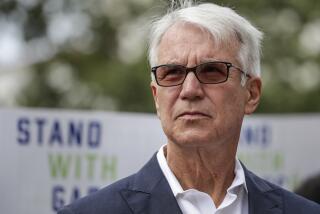Floridaâs Tough Teen Crime Stance May Be Wrong Cure
LAKELAND, Fla. â âThis is a jack!â someone shouted.
Tim Miller, who had spent 10 years as the lone clerk at a drive-through beverage store, looked up to see two guns pointed at him. The faces behind them were very cold, very mean--and very young.
âYou gotta be kidding,â Miller blurted out.
One kid, at 5 feet 2, could barely see above the drive-through window. A seventh-grader, he had turned 13 the week before.
He thrust the gun within inches of Millerâs face. âShoot him!â shouted another gun toter, a 14-year-old.
âI could see the hair on his finger as he pulled the trigger,â Miller said later.
A safety stopped the gun from firing. Miller turned and took a step and was shot in the back. The bullet cut across his kidney, tore his intestine and lodged as a hard knot in his belly.
The kid and his 14-year-old buddy jumped back into the stolen car and the driver, 15, gunned the engine to resume their after-school joy ride.
Just a few years ago, even so brutal a crime would have landed these âyouthful offendersâ in a juvenile court. They might have been ordered to spend a year or two in a state camp for periodic or violent juvenile delinquents. But these three boys now are in state prison.
In 1994, shortly after a British tourist was killed by three teenagers at a highway rest stop, Floridaâs Legislature gave county prosecutors and judges more authority to try juveniles as adults and sentence them to regular state prisons.
âFlorida is leading the way toward a get-tough attitude on juvenile crime,â said Thomas Blomberg, a criminologist at Florida State University. âThe feeling now is that there is a new generation of vicious young people out there and the only answer is to lock âem up and throw away the key.â
Republican presidential candidate Bob Dole is trying to capitalize on that feeling. In his weekly radio address last Saturday, he proposed making juvenilesâ criminal records stick with them all their lives. As a senator, he had supported legislation to force juveniles accused of violent federal crimes to be tried as adults.
âTeenagers who rape, rob and murder should not be automatically released when they turn 18 or 20,â Dole said.
Effects of Doing Time
Crime experts say that Florida is now sending more juveniles directly into the adult system than all the other states combined. âIn most states, it is several hundred a year,â said University of Florida sociologist Charles E. Frazier. âIn Florida, we transfer as many as 7,000 into adult court every year.â
Only a small percentage of those young defendants are convicted and sentenced to a state prison. But the initial evidence suggests that doing time alongside convicted murderers and armed robbers is not steering young offenders away from lives of crime.
In fact, a recent University of Florida study found that juveniles who were sent to adult prisons were more likely to commit serious crimes after they were released than those who committed similar offenses and were sent to juvenile facilities.
âThe indications are it is having no beneficial effect and it may be heading us in the wrong direction,â said Frazier, a co-author of the study.
Last year, the first in which Floridaâs new juvenile justice system was in full operation, about 5% of youthful offenders were tried as adults, state officials said, and 652 youths under 18 were locked up in state prisons.
While the new approach may not deter juvenile crime, it is removing at least some violent youths from the streets.
âThe old system was toothless. And everybody knew it,â said Vincent J. Patrucco, the Polk County prosecutor.
Teenagers who repeatedly committed crimes were given something less than a slap on the wrist. Their âpunishmentâ was to spend a month or more at a state wilderness camp.
âThe joke around here was, âYou steal 10 cars in Polk County and we give you a 30-day canoe trip,â â said state Judge Charles A. Davis Jr.
Florida may have a head start, but virtually every state has lowered the age at which accused criminals can be tried as adults. In California, the minimum age is 14; in some other states, 12- and 13-year-olds who commit murder are often tried as adults and, if convicted, sent to adult prisons.
Princeton professor John J. DiIulio Jr. said that todayâs new breed of âjuvenile superpredatorsâ have no sense of right and wrong and no remorse over violent assaults on others. These young people need to be locked up, he declared, not sent through âthe revolving door of the juvenile justice system.â
Frustrated prosecutors and state lawmakers said that revolving door convinced many trouble-prone youths that they could get away with anything.
Even today, most juvenile offenders are put on probation or, at most, sent away for a monthâs detention at a campus-like facility for troubled teens. Only the most severe cases, usually involving murder, attempted murder, rape or aggravated assault, are transferred to the adult system.
Many crime experts question the wisdom of mixing teens with hardened criminals.
âItâs ineffectual and a waste of money,â said Florida Stateâs Blomberg. Most juvenile offenders will not be deterred by the prospect of going to prison for decades, he said.
âThe typical crime career begins at age 15 and ends at 22,â Blomberg said, and the worst young offenders should be confined in juvenile facilities until then.
Undoing Reforms
This decadeâs epidemic of youth violence has reversed some of the far-reaching changes made in the juvenile justice system at the turn of the century. Then, reformers demanded a separate system of courts and facilities to handle young lawbreakers.
They insisted that the young and immature--those under 18--could not be held fully responsible for their acts. They even called for a separate terminology. Rather than speak of âyoung criminals,â reformers spoke of âjuvenile offendersâ who engaged in âacts of delinquency.â
Because âjuvenile offendersâ were too young to be held fully responsible, their names were kept confidential. The worst of them were sent to âreformatories.â By age 21, they were released and their records were wiped clean.
Now state after state is casting aside this system of reform and rehabilitation in favor of the swifter and harsher punishment of adult courts. Convicted criminals, even as young as age 13, are being locked up in state prisons.
âIf a kid commits a violent crime, he ought to be treated like any other criminal,â said Steven Jerrell, a Jefferson County, Mo., prosecutor who is handling the case of Michael Est, a 14-year-old accused of killing his father for complaining that he was playing his music too loudly. A murder is a murder, he said, no matter the age of the murderer.
No national statistics are available on the number of juveniles sent to adult prisons, according to the Justice Department, but officials believe that the total is quite small. In 1993, only about 2% of juvenile offenders were transferred to adult courts, the department said. However, this total represented a 41% increase over four years before.
The notion that youth crimes should be kept confidential is also fast disappearing. The Texas Legislature, for example, recently opened up records of juvenile offenses and juvenile court proceedings. Gov. George W. Bush said that he wants to hold âlittle thugsâ fully responsible for their crimes.
Going Too Far?
Many child-welfare advocates said that the get-tough reaction has already gone too far.
âThe juvenile justice system began because of the outcry over dumping kids into adult prisons,â said Paolo Annino, director of the Child Advocacy Center in Tallahassee, Fla. âThey could be raped. It also turned kids into hardened criminals. Now weâre heading back to the old system. We are abandoning rehabilitation and just dumping kids in with adult prisoners.â
Here in Lakeland, that was the fate of the boys who shot the convenience store clerk. In February, they became three of the youngest inmates in the Florida state prison system.
They were exactly the sorts of youth that Floridaâs crackdown was aimed at: young, casual, cold-blooded, utterly remorseless. When police finally caught up with them after a high-speed chase across the county, they laughed, sneered and mugged for a photographer.
âItâs scary,â defense lawyer Deborah L. Wells said in a near whisper. Wells represented the 13-year-old who stuck the gun in Tim Millerâs face. When she asked him why he did it, he did not reply.
âI donât think he had any intent,â Wells said. âHe was being stupid. He was being 13. I really think these guys do it to impress their friends.â
Patrucco, the prosecutor, called the young criminals âdevoid of conscience. Thatâs whatâs so frightening. They have no sense of the harm they do.â
After being arrested and told that they would be held in the county jail, the three juveniles realized that this was no joke, Patrucco said. âBut not once,â he added, âdid they show a shred of concern or interest in what happened to Tim Miller.â
Miller was on the phone talking with his wife on the November afternoon in 1994 when three juveniles drove up in a car they had stolen from a hospital parking lot after school. His memory of the shooting remains vivid.
âI heard the pop and it knocked me down,â he said. He was able to tell his wife that he had been shot and that she should call the police.
Lying on the floor, he thought he was going to die. âI could feel the bullet in my stomach. The pain got intense.â
A fast-acting ambulance unit and a surgeon saved his life. While recovering, Miller determined to speak out in favor of punishing the juveniles as adult criminals.
âIâm all in favor of rehabilitation, but you donât send someone off to one of these camps for trying to kill someone,â he said.
The youths were indicted by a Polk County grand jury for attempted murder but pleaded guilty to lesser charges.
The two gun toters, Rasha Honors, the 13-year-old, and Kenvon Burch, the 14-year-old, pleaded guilty to aggravated battery with a firearm, and the driver, Orteago Pearson, pleaded guilty as an accomplice.
At the sentencing hearing, the court-appointed defense lawyers asked that their three clients be sent to a private campus in Pennsylvania that had succeeded in turning around troubled youth.
âCall me a bleeding-heart liberal, but Iâm amazed anyone would think sending a 13-year-old away to prison is the solution to the problem,â said attorney Wells.
Judge Robert A. Young said that soft sentences would deliver a clear message to the guilty that their crimes would go unpunished. On the other hand, he said, putting them in state prison for a few years âprobably means they will come out as hardened criminals.â
He sentenced all three to at least three years behind thick strands of gleaming barbed wire at an adult state prison near Orlando. Sending them to a juvenile facility, Young said, âwould be seen as no punishment at all. This will have an impact in the community.â
Perhaps so. After a year and a half, however, the sentences have not apparently left a deep imprint on the two teenagers who brandished the guns.
âI donât think about it no more,â Honors, now 14, said of the shooting. âIt just happened.â
Thickly built with a broad face, Honors mostly gives polite yes or no answers to an interviewer, then smiles and looks down. For the interview, he is handcuffed and wearing an orange jumpsuit.
Burch, who had called out for him to shoot the clerk, is more animated and articulate. But he has no better explanation.
Typical Profile
âI just did it,â Burch said. âI wasnât thinking of anything. We went there for a robbery. I wasnât thinking about the outcome. When the dude went to turn away, Honors shot him.â
The three Lakeland teenagers match the profile of likely criminals: broken families, failure in school, access to guns. Only one of the three knows his father. And thatâs because the father, an inmate in another state prison, wrote to his son offering legal advice. Donât tell the police anything, he advised. Good advice, but a bit late; his son had already confessed.
The three boys concurred with the prosecutorâs view that the old juvenile justice system was a joke. After stealing several cars, they had been assigned âcommunity control,â a supposedly supervised form of probation.
What did it actually mean?
âNothing,â one replied.
Of the three, only Pearson sounded remorseful and determined to straighten out his life when he is released. For now, the 16-year-old said that he actually is glad to be behind bars.
âOtherwise,â he said, âIâd probably be dead.â In the last year, he said, his brother and three close friends have been shot and killed.
The young guys in his neighborhood âwant the fast moneyâ from selling drugs, he said, and they will kill anyone who gets in their way. In prison, Pearson said he has been studying for his high school equivalency exam and reading the Bible.
âI know I gotta change or Iâll end up dead.â
His companions are making no such promises. Asked what he would like to do when he is released, Honors shrugged.
âI canât say Iâll walk the straight line,â Burch offered. âIâll try, but I donât know if I will.â
Judge Young has the awful feeling that he will see these young men again.
Boot camps, juvenile centers and even prisons can straighten out young men in their custody, Young said. But when they return home to their old neighborhoods, they usually go back to crime.
Not only is rehabilitation failing, Young said, but the number of youths from poor, single-parent families will rise steadily over the next decade.
âLook at these young men,â the judge said, âand look at the demographics. Itâs scary as hell.â
More to Read
Sign up for Essential California
The most important California stories and recommendations in your inbox every morning.
You may occasionally receive promotional content from the Los Angeles Times.











